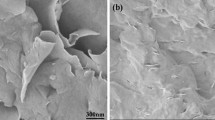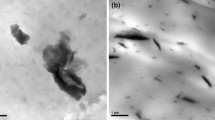Abstract
Nano-clays and flame retardant composite-modified asphalt has obvious synergistic effects, but the effect of nano-clays on the flame retardant properties, rheological properties, and flame retardant mechanism of flame retardant-modified asphalt has not been studied. In this paper, synergistic flame retardants containing nano-clays and targeted flame retardant (TFR) were prepared and used as nanocomposite flame retardant (NCFR) to modified asphalt (NFRMA). Nano-clays are two types of nano-silicate clays: halloysite nanotubes (HNTs) and organic nano-montmorillonite (OMMT). The flame retardant properties, rheological properties, and flame retardant mechanism of NFRMA have been studied. The results show that the two kinds of NFRMA exhibit obvious synergistic effects. Among them, HNTs can significantly increase the limiting oxygen index and self-ignition temperature of flame retardant asphalt, but OMMT can significantly inhibit the generation of smoke in asphalt combustion process. Both HNTs and OMMT can effectively improve the high-temperature performance of asphalt. The effect of HNTs in improving the high-temperature performance of asphalt is more obvious than that of OMMT. At the same time, HNTs can also improve the degradation of low-temperature performance of asphalt by TFR. However, OMMT will further deteriorate the low-temperature performance of asphalt. The flame retardant enhancement mechanism of HNTs and OMMT mainly enhances the flame retardant performance of asphalt through its own decomposition and heat absorption and improvement of the barrier layer structure. HNTs are more efficient in improving the integrity of the barrier layer, while OMMT exhibits better smoke suppression performance.












Similar content being viewed by others
Data availability
Data will be made available on request.
References
Qiu JL, Yang T, Wang XL, Wang LX, Zhang G (2019) Review of the flame retardancy on highway tunnel asphalt pavement. Constr Build Mater 195:468–482. https://doi.org/10.1016/j.conbuildmat.2018.11.034
Chen R, Zhao RK, Liu Y, Xi ZH, Cai J, Zhang JS, Wang QJ, Xie HF (2021) Development of eco-friendly fire-retarded warm-mix epoxy asphalt binders using reactive polymeric flame retardants for road tunnel pavements. Constr Build Mater 284:122752. https://doi.org/10.1016/j.conbuildmat.2021.122752
Xu T, Huang XM (2010) Study on combustion mechanism of asphalt binder by using TG-FTIR technique. Fuel 89:2185–2190. https://doi.org/10.1016/j.fuel.2010.01.012
Xia WJ, Wang SW, Wang H, Xu T (2021) Inhibitory effects of developed composite flame retardant on bituminous combustion and volatile emissions. J Clean Prod 279:123538. https://doi.org/10.1016/j.jclepro.2020.123538
Xiao FP, Guo R, Wang JG (2019) Flame retardant and its influence on the performance of asphalt - a review. Constr Build Mater 21:841–861. https://doi.org/10.1016/j.conbuildmat.2017.01.064
Ding QJ, Liu XQ, Shen F, Hu SG (2008) Test and mechanism analysis of ATH asphalt flame-retarding system. China J Highw Transp 21(5):10–14. https://doi.org/10.19721/j.cnki.1001-7372.2008.05.003
Huang ZY, Wu B, Kang C, Zhu KWuK (2016) Flame retardant and pavement performance of composite hydroxide modified asphalt. J Zhejiang Univ 50(1):27–32. https://doi.org/10.3785/j.issn.1008-973X.2016.01.05
Yang XL, Wang GC, Liang MM, Yuan TP, Rong HL (2021) Effect of aluminum hydroxide (ATH) on flame retardancy and smoke suppression properties of SBS-modified asphalt. Road Mater Pavement 2021:2012239. https://doi.org/10.1080/14680629.2021.2012239
Ling TQ, Zhang RZ, Ning HY, Yuan M (2011) Study on flame retardant performance of intumescent asphalt flame retardant. J Chongqing Jiaotong Univ 30(5):948–951+988. https://doi.org/10.3969/j.issn.1674-0696.2011.05.014
Jin L, Wei JG, Fu QL, Zhang QJ (2020) Effect of DBDPE composite flame retardant on the performance of SBS asphalt. J Chang’an Univ 40(02):47–55+65. https://doi.org/10.19721/j.cnki.1671-8879.2020.02.006
He LP, Shen AQ, Liang JL, Xie C (2013) Flame retardant and pavement performance of flame retardant asphalt and asphalt mixture. J Highw Transp Res Dev 30(12):15–22. https://doi.org/10.3969/j.issn.1002-0268.2013.12.003
Wei JG, Xie C, Fu QL (2013) Influence of flame retardant on technical performances of asphalt and asphalt Mixture. China J Highw Transp 26(6):30–37. https://doi.org/10.19721/j.cnki.1001-7372.2013.06.005
Qin XT, Zhu SY, Chen SF, Deng KY (2013) The mechanism of flame and smoke retardancy of asphalt mortar containing composite flame retardant material. Constr Build Mater 41:852–856. https://doi.org/10.1016/j.conbuildmat.2012.12.048
Tan YQ, Lan BW, Ji L, Shang YF (2009) Modified techniques of commonly-used flame-retardant asphalt in asphalt pavement tunnel. J Chongqing Jiaotong Univ 28(4):711–719. 1674–0696(2009)04–0711–04
Fu QL, Wei JG, Peng WJ, Jin L (2020) Performance and flame retardant mechanism of coordinated flame retardant asphalt with DBDPE and Sb2O3. China J Highw Transp 33(02):44–55. https://doi.org/10.19721/j.cnki.1001-7372.2020.02.004
Yang XL, Shen AQ, Guo YC, Wu HS, Wang H (2021) A review of nano layered silicate technologies applied to asphalt materials. Road Mater Pavement 22(8):1708–1733. https://doi.org/10.1080/14680629.2020.1713199
Li RY, Xiao FP, Amirkhanian S, You ZP, Huang J (2017) Developments of nano materials and technologies on asphalt materials – a review. Constr Build Mater 143(15):633–648. https://doi.org/10.1016/j.conbuildmat.2017.03.158
Daniel GG, David GS, Vicent F, Juan LM, Rafael B (2018) Improvement of mechanical and thermal properties of poly(3-hydroxybutyrate) (PHB) blends with surface-modified halloysite nanotubes (HNT). Appl Clay Sci 162:487–498. https://doi.org/10.1016/j.clay.2018.06.042
Olawale MS, Abdelkibir B, Nourredine AH (2020) Clays and carbon nanotubes as hybrid nanofillers in thermoplastic-based nanocomposites – a review. Appl Clay Sci 185:105408. https://doi.org/10.1016/j.clay.2019.105408
Eleni GK, Eleni GI, Konstantinos A, Dimitrios P (2021) Applications of halloysite in tissue engineering. Appl Clay Sci 214:106291. https://doi.org/10.1016/j.clay.2021.106291
Yang XL, Shen AQ, Jiang YX, Meng YJ, Wu HS (2021) Properties and mechanism of flame retardance and smoke suppression in asphalt binder containing organic montmorillonite. Constr Build Mater 302:124148. https://doi.org/10.1016/j.conbuildmat.2021.124148
Zhang HL, Shi CJ, Han J, Yu JY (2013) Effect of organic layered silicates on flame retardancy and aging properties of bitumen. Constr Build Mater 40:1151–1155. https://doi.org/10.1016/j.conbuildmat.2012.11.097
Zhu K, Tang DQ, Huang YD, Wang Q, Wu K (2019) Mechanism of flame and smoke retardancy of asphalt with ZnMgAl-CO3-LDHs. J Build Mater 22(04):599–605. https://doi.org/10.3969/j.issn.1007-9629.2019.04.014
Zhu K, Wang YH, Tang DQ, Wang Q, Li HH, Huang YD, Huang ZY, Wu K (2019) Flame-retardant mechanism of layered double hydroxides in asphalt binder. Materials 12:801. https://doi.org/10.3390/ma12050801
Shen AQ, Wu HS, Guo YC, Yang XL, He ZM, Li Y (2021) Effect of layered double hydroxide on rheological and flame-retardant properties of styrene-butadiene-styrene modified asphalt. J Mater Civ Eng 33(2):04020454. https://doi.org/10.1061/(ASCE)MT.1943-5533.0003534
Li ML, Pang L, Chen MZ, Xie J, Liu QT (2018) Effects of aluminum hydroxide and layered double hydroxide on asphalt fire resistance. Materials 11:11101939. https://doi.org/10.3390/ma1110193
Bonati A, Merusi F, Bochicchio G, Tessadri B, Polacco G, Filippi S, Giuliani F (2013) Effect of nanoclay and conventional flame retardants on asphalt mixtures fire reaction. Constr Build Mater 47:990–1000. https://doi.org/10.1016/j.conbuildmat.2013.06.002
Liang YS, Yu JY, Feng ZG, Ai PS (2013) Flammability and thermal properties of bitumen with aluminium trihydroxide and expanded vermiculite. Constr Build Mater 48:1114–1119. https://doi.org/10.1016/j.conbuildmat.2013.07.074
Yang XL, Shen AQ, Su YX, Zhao WD (2020) Effects of alumina trihydrate (ATH) and organic montmorillonite (OMMT) on asphalt fume emission and flame retardancy properties of SBS-modified asphalt. Constr Build Mater 236:117576. https://doi.org/10.1016/j.conbuildmat.2019.117576
Tan YW, He ZY, Li X, Jiang B, Li JQ, Zhang YG (2020) Research on the flame retardancy properties and mechanism of modified asphalt with halloysite nanotubes and conventional flame retardant. Materials 13(20):4509. https://doi.org/10.3390/ma13204509
Li JQ, He ZY, Yu L, He L, Shen ZZ (2021) Multi-objective optimization and performance characterization of asphalt modified by nanocomposite flame-retardant based on response surface methodology. Materials 14:4367. https://doi.org/10.3390/ma14164367
Tan YW, Xie JG, Wu YF, Wang ZQ, He ZY (2023) Performance and microstructure characterizations of halloysite nanotubes composite flame retardant modified asphalt. J Mater Civ Eng 35(3):04022448. https://doi.org/10.1061/(ASCE)MT.1943-5533.0004630
Batistella MA, Sonnier R, Otazaghine B, Petter CO, Lopez-Cuesta JM (2018) Interactions between kaolinite and phosphinate-based flame retardant in Polyamide 6. Appl Clay Sci 157:248–256. https://doi.org/10.1016/j.clay.2018.02.021
Pei JZ, Wen Y, Li YW, Shi X, Zhang JP, Li R, Du QL (2014) Flame-retarding effects and combustion properties of asphalt binder blended with organo montmorillonite and alumina trihydrate. Constr Build Mater 72:41–47. https://doi.org/10.1016/j.conbuildmat.2014.09.013
Yuan P, Tan DY, Faïza AB (2015) Properties and applications of halloysite nanotubes: recent research advances and future prospects. Appl Clay Sci 112–113:75–93. https://doi.org/10.1016/j.clay.2015.05.001
Barick AK, Tripathy DK (2011) Effect of organically modified layered silicate nanoclay on the dynamic viscoelastic properties of thermoplastic polyurethane nanocomposites. Appl Clay Sci 52:312–321. https://doi.org/10.1016/j.clay.2011.03.010
Mahsa N, Azam JA, Karim G (2014) Organoclay maleated natural rubber nanocomposite. Prediction of abrasion and mechanical properties by artificial neural network and adaptive neuro-fuzzy inference. Appl Clay Sci 97–98:187–199. https://doi.org/10.1016/j.clay.2014.05.027
Vargas MA, Moreno L, Montiel R, Manero O, Vázquezc H (2017) Effects of montmorillonite (Mt) and two different organo-Mt additives on the performance of asphalt. Appl Clay Sci 112–139:20–27. https://doi.org/10.1016/j.clay.2017.01.009
Wu K, Huang ZY, Xu X (2009) Research on thermal effect of asphalt pavement combustion in long tunnel fires. China J Highw Transp 22(2):77–81. https://doi.org/10.19721/j.cnki.1001-7372.2009.02.014
Bonati A, Rainieri S, Bochicchio G, Tessadri B, Giuliani F (2015) Characterization of thermal properties and combustion behavior of asphalt mixtures in the cone calorimeter. Fire Saf J 74:25–31. https://doi.org/10.1016/j.firesaf.2015.04.003
Qian GP, Yu HN, Gong XB, Zheng WF (2019) Effect of phosphorus slag powder on flammability properties of asphalt. J Mater Civ Eng 31(11):1104019280. https://doi.org/10.1061/(ASCE)MT.1943-5533.0002951
Li LH, Zou SL, Chen CY (2012) Study on the flame retardant and smoke suppression performance and road performance of flame retardant asphalt mixture. J Build Mater 15(05):648–653. https://doi.org/10.3969/j.issn.1007-9629.2012.05.013
Di HB, Zhang H, Yang EH, Ding HB (2023) Usage of Nano-TiO2 or Nano-ZnO in asphalt to resist aging by NMR spectroscopy and rheology technology. J Mater Civ Eng 35(1):04022391. https://doi.org/10.1061/(ASCE)MT.1943-5533.0004570
Liu JW, Hao PW, Sun BW, Li Y, Wang YD (2022) Rheological properties and mechanism of asphalt modified with polypropylene and graphene and carbon black composites. J Mater Civ Eng 34(12):04022343. https://doi.org/10.1061/(ASCE)MT.1943-5533.0004513
Jia M, Zhang Z, Wei L, Li J, Yuan D, Wu X, Mao Z (2019) High- and low temperature properties of layered silicate-modified bitumens: view from the nature of pristine layered silicate. Appl Sci 9:3563. https://doi.org/10.3390/app9173563
Shi HQ, Xu T, Zhou P, Jiang RL (2017) Combustion properties of saturates, aromatics, resins, and asphaltenes in asphalt binder. Constr Build Mater 136:515–523. https://doi.org/10.1016/j.conbuildmat.2017.01.064
Tao Xu, Wang Y, Xia WJ, Hu ZH (2018) Effects of flame retardants on thermal decomposition of SARA fractions separated from asphalt binder. Constr Build Mater 173:209–219. https://doi.org/10.1016/j.conbuildmat.2018.04.052
Li JS, Wu W, Hu H, Rui ZG, Zhao TY, Zhang XY (2022) The synergism effect of montmorillonite on the intumescent flame retardant thermoplastic polyurethane composites prepared by selective laser sintering. Polym Compos 43(9):5863–5876. https://doi.org/10.1002/PC.26621
Acknowledgements
All the authors of the following references are much appreciated.
Funding
This research was supported by the National Natural Science Foundation of China (51978116) and Graduate Scientific Research and Innovation Foundation of Chongqing, China (Grant No. CYS20283).
Author information
Authors and Affiliations
Contributions
Yangwei Tan: Investigation, conceptualization, writing—original draft, writing—review. Jianguang Xie: Writing—review, supervision, project administration. Zhanqi Wang: Data curation and analysis. Kuan Li: Writing—review, conceptualization. Zhaoyi He: Methodology, writing—review
Corresponding author
Ethics declarations
Conflict of interest
The authors declare no competing interests.
Additional information
Publisher's note
Springer Nature remains neutral with regard to jurisdictional claims in published maps and institutional affiliations.
Highlights
• Synergistic enhancement effect of HNTs and OMMT combined with TFR on flame retardancy of asphalt was found.
• The effect of HNTs and OMMT on the rheological properties of asphalt modified by TFR was studied.
• The synergistic enhancement mechanism of HNTs and OMMT on flame retardant performance of asphalt was discussed based on TGA-DSC, TG-FTIR, and DIP-SEM.
This article is part of the topical collection: "Part of S.I Nanoarchitectonics for Functional Particles and Materials"
Rights and permissions
Springer Nature or its licensor (e.g. a society or other partner) holds exclusive rights to this article under a publishing agreement with the author(s) or other rightsholder(s); author self-archiving of the accepted manuscript version of this article is solely governed by the terms of such publishing agreement and applicable law.
About this article
Cite this article
Tan, Y., Xie, J., Wang, Z. et al. Effect of halloysite nanotubes (HNTs) and organic montmorillonite (OMMT) on the performance and mechanism of flame retardant-modified asphalt. J Nanopart Res 25, 74 (2023). https://doi.org/10.1007/s11051-023-05697-3
Received:
Accepted:
Published:
DOI: https://doi.org/10.1007/s11051-023-05697-3




